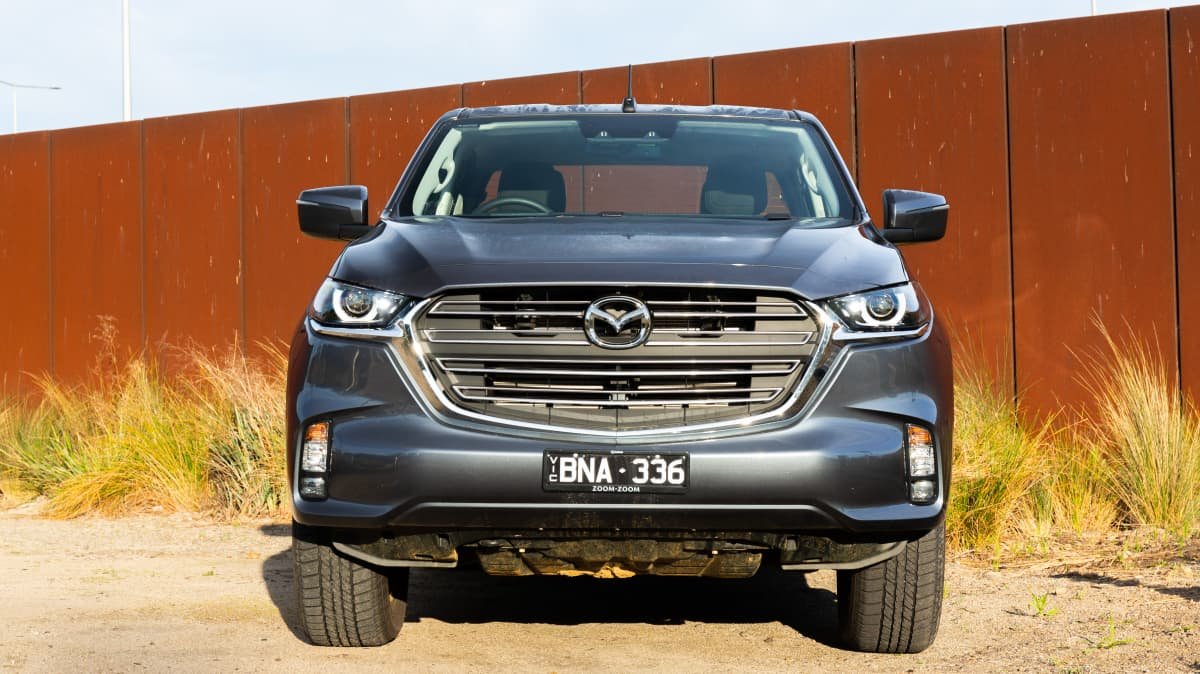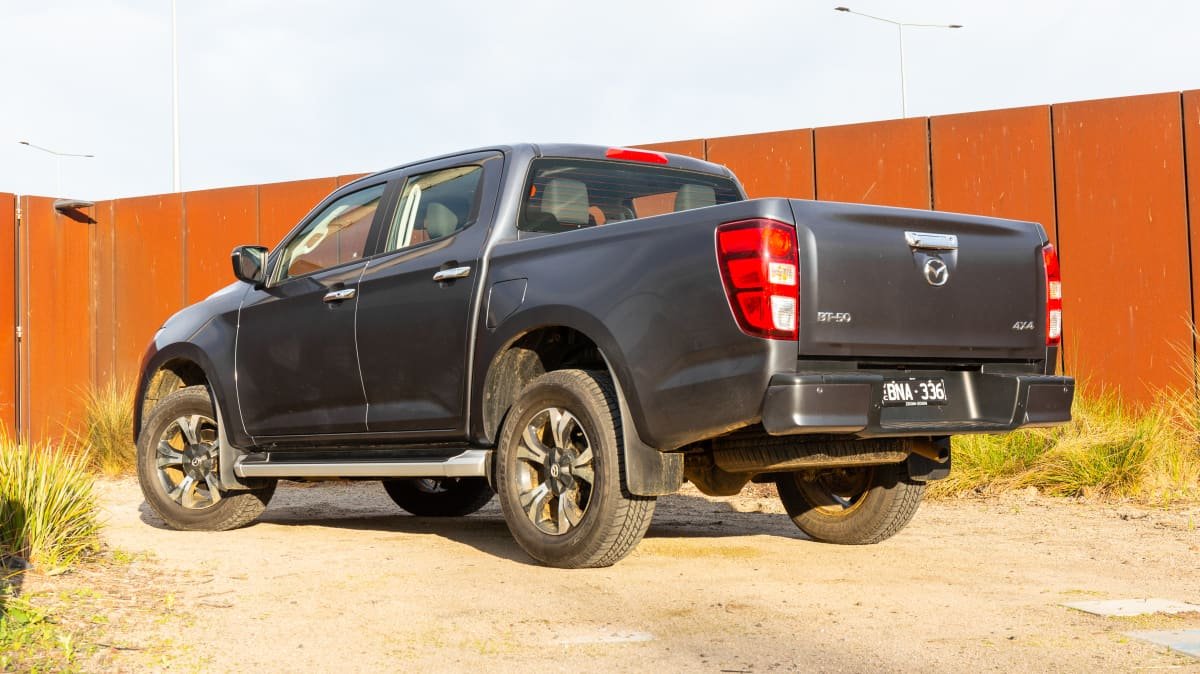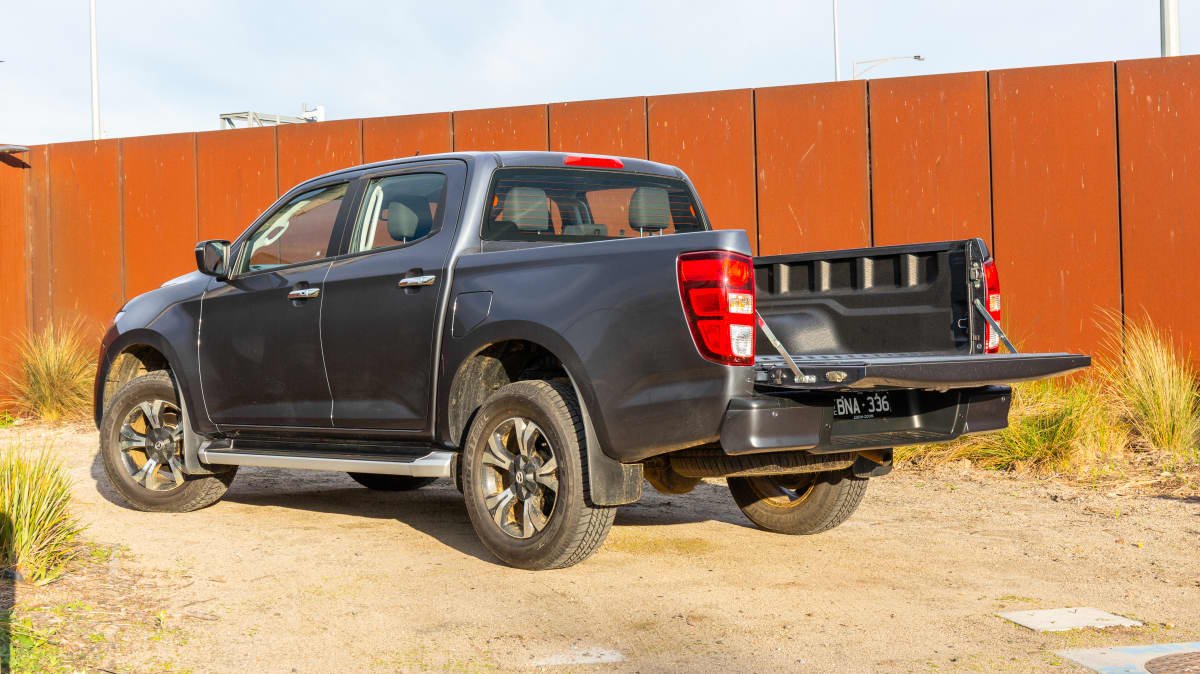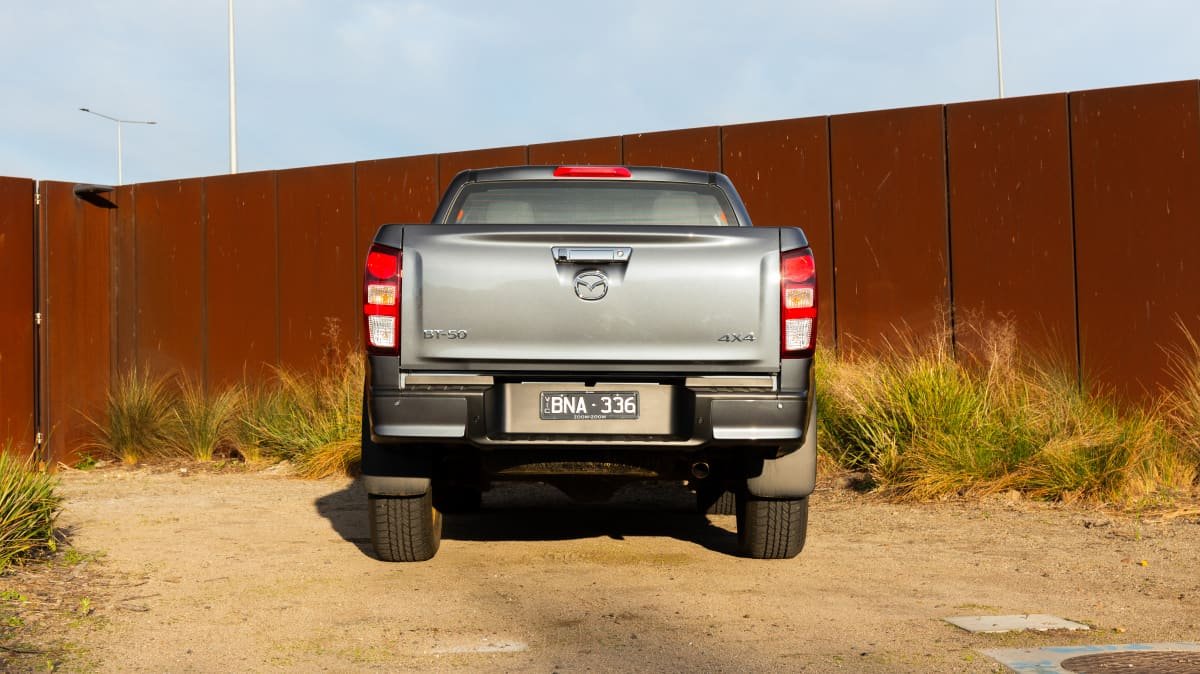[bsa_pro_ad_space id=14]
- Doors and Seats
- Engine
- Engine Power
- Fuel
- Manufacturer
- Transmission
- Warranty
- Ancap Safety

Is the 2021 Mazda BT-50 more than just the Isuzu D-Max’s twin? We put the BT-50 XTR 4×4 to the test to find out.
- Safety credentials among the best in segment
- Step-up in cabin fit and finish
- Space in the second row
- Aftermarket-feeling infotainment system
- Busy, jittery ride around town
- Questionable value proposition against competition
If 2020 gave us nothing else, there certainly were a great deal of new and refreshed dual-cab utes hitting the market throughout a tumultuous 12 months. One of the more substantial reveals was the all-new new Mazda BT-50’s debut, which not only features vastly different looks to its predecessor, but also scores an all-new (to Mazda, at least) platform.
While it mightn’t look it from the outside, the car is a wholesale reskin of the 2021 Isuzu D-Max’s underpinnings. That means it shares fundamentals of ladder-frame chassis, the same 3.0-litre turbo-diesel engine, and even bulk interior fittings and equipment.
Most differences between the twins-under-the-skin exist within specification and variant offerings.
Against the wider competition, the Mazda BT-50 battles rivals including the Nissan Navara, Toyota HiLux, Mitsubishi Triton, Ford Ranger, and Volkswagen Amarok.
All variants in the Mazda BT-50 range are powered by a 3.0-litre turbo-diesel four-cylinder engine that outputs 140kW and 450Nm through a six-speed transmission – manual or automatic.
Trainspotters will notice those figures are down on the previous generation’s 147kW and 470Nm outputs, but importantly, the current BT-50 retains a 3500kg tow rating and is also lighter.
A great deal of interest is placed on the top-spec offerings in dual-cab ute line-ups, but there’s arguably better value in the mid-tier zone, which is why we’ve spent some time behind the wheel of the $57,210 (before on-road costs) 2021 Mazda BT-50 XTR 4×4 dual-cab automatic.
The exterior is distinguished by 18-inch alloy wheels, LED headlamps, LED daytime running lamps, chrome door handles, side steps, and advanced keyless entry.
While it looks similar to the Isuzu D-Max’s interior, the new Mazda BT-50’s cabin is a huge step-up over its predecessor’s space. There’s far less dull plastic around, especially at the all-important touchpoints, and tech has all been updated with larger screens and new software.
The XTR spec gets enhancements including dual-zone climate control, leather-wrapped steering wheel, rear seat with centre armrest, a 9.0-inch touchscreen with wireless Apple CarPlay and Android Auto (or the option of a wired connection if you’d prefer), native satellite navigation, digital radio, reverse camera, and adaptive cruise control.
Space up front feels comfortable, though legroom is a bit short for taller drivers. Storage is very well catered to as well, with a small shelf in front of the shifter, a pair of cupholders on the centre console, and a large centre console bin – though the D-Max’s extra pop-out cup holders on each side of the dash aren’t to be found in the Mazda. There is also a large glovebox and a secondary storage box within the dash, which comes in handy for hiding away your expensive stuff when leaving the car.
| 2021 Mazda BT-50 XTR 4×4 | |
| Seats | Five |
| Length | 5280mm |
| Width | 1870mm |
| Height | 1790mm |
| Wheelbase | 3125mm |
Fit, finish and presentation of the cabin feel far more ‘lifestyle’ ute than the BT-50 of old, and only let down by hard plastic door tops.
Get a great deal today
Interested in this car? Provide your details and we’ll connect you to a member of the Drive team.
The black cloth seats found favour with the Drive office, with great shoulder support and a comfortable, form-fitting frame. The seats are fairly easily manipulated into an ideal, high-perch driving position.
Back seat dwellers are especially well catered to, with a great amount of legroom and good space side to side. There’s also a good few amenities on offer such as a bag hook, map pockets, air vents, and a single USB-A port. A fold-down armrest also contains a pair of cupholders.
Having the air-conditioning controls at hand underneath the infotainment screen is handy – the simple layout is appreciated rather than embracing the trend of having those controls embedded within the infotainment system. A tub liner (an $850 genuine accessory) in the tray helps protect the paint underneath, and a number of tie-down points help secure larger items when on the move.
Infotainment and Connectivity
Technology has also seen a big boost in this newer-generation car, with the XTR scoring a larger 9.0-inch touchscreen over lower-spec variants in the range, as well as a digital display within the instrument cluster.
Because it’s shared with the Isuzu D-Max, the BT-50’s infotainment feels a bit more aftermarket than we’ve come to expect from Mazda. It’s a shame because Mazda’s previous MZD Connect (or current Mazda Connect) software is arguably some of the best.
Even still, the 9.0-inch system gets the job done – though it is basic. There are some shortcuts along the bottom of the screen to jump to different functions and there is native satellite navigation for finding your way. Annoyingly, the system plays an obnoxious beeping noise whenever you touch the screen, but that’s easily turned off.
Interestingly, while you can use the BT-50’s smartphone mirroring wirelessly, though there is no wireless phone charging on offer. To plug in and charge items, Mazda has provided a USB-A port up front and a 12-volt outlet, plus the option to use phone projection with a wired connection if you’d prefer.
The Mazda’s safety specification is right up there with the best of the dual-cab utes. It gets a five-star ANCAP safety rating (2020 rating) and a full suite of active safety features including autonomous emergency braking, adaptive cruise control, lane-keep assist, lane-departure warning, blind-spot monitoring, rear cross-traffic alert, and traffic sign recognition.
The car will sound a beep whenever you go over the speed limit, though that does become annoying when going through school zones outside of school hours.
The BT-50’s lane-keep assist system is heavy-handed and regularly cuts in when not needed. It will forcefully steer you back into your lane if it deems you’re veering.
Other driving technologies include hill descent control that, when used on test, takes care of braking, traction and the gearbox to reassuringly guide you down large hills. For peace of mind out of town, there’s also a full-size spare alloy wheel slung under the rear.
| At a glance | 2021 Mazda BT-50 XTR 4×4 |
| ANCAP rating & year tested | Five stars (tested 2020) |
| Safety report | Link |
With the BT-50, Mazda offers a five-year/unlimited-kilometre warranty as well as roadside assistance for the same period. Capped-price servicing covers the first five service centre visits at 15,000km or 12-month intervals. Three years’ worth of servicing is set to cost $1493 and five years will cost $2307.
Against Mazda’s 8.0L/100km combined fuel consumption claim, our actual on-test recording was 9.3L/100km. This is an average fuel consumption we’ve come to expect from dual-cab utes. The fuel tank can hold 76L of diesel.
| At a glance | 2021 Mazda BT-50 XTR 4×4 |
| Warranty | Five years / unlimited km |
| Service intervals | 12 months / 15,000km |
| Servicing costs | $1493 3yr / $2307 5yr |
| Fuel cons. (claimed) | 8.0L/100km |
| Fuel cons. (on test) | 9.3L/100km |
| Fuel tank size | 76L |
Among the other things the Mazda BT-50 shares with the Isuzu D-Max, both are built in the same factory and use a 3.0-litre four-cylinder turbo-diesel Isuzu engine. The 140kW and 450Nm outputs are sent to a part-time four-wheel drivetrain through a six-speed automatic transmission.
The set-up feels entirely adequate for around-town usage, with enough torque on tap to keep you out of trouble and an intelligent gearbox that downshifts when you need it to. Remember, too, while slightly different to the old 3.0-litre engine, Isuzu motors have regularly found fans within the 4×4 community for their reliability and durability.
Even though it’s not super punchy in the same way as other utes like a Volkswagen Amarok or a Ford Ranger, overtakes are dispatched quick enough and it’ll easily get up to freeway speeds without fuss.
The ride quality doesn’t quite get such an endorsement, especially around town. It feels fidgety and jitters over minor imperfections to a higher degree than its competition when unladen. There’s minimal feel to the steering, but the light feel is actually nice and easy to use, especially around town manoeuvring the long 5280mm body.
Off-road, the BT-50 handled the big hill we threw at it without much complaint. In the case where we ran into trouble, the big BT was easily reversed back using the high-definition reverse camera. The traction-control system keeps things in check when travelling on tight and twisty adjoining gravel roads.
Resident off-road expert Sam Purcell has completed more substantial off-road trips in the current-gen BT-50, in which it scored a respectable pass mark in standard form. Adventuring could be improved with some all-terrain tyres and more recovery points – even a tow bar would be nice.
| Key details | 2021 Mazda BT-50 XTR 4×4 |
| Engine | 3.0-litre four-cylinder turbo diesel |
| Power | 140kW @ 3600rpm |
| Torque | 450Nm @ 1600-2600rpm |
| Drive type | Part-time 4×4, low-range transfer case |
| Transmission | Six-speed automatic |
| Power to weight ratio | 69.0kW/t |
| Weight (kerb) | 2030kg |
| Tow rating | 3500kg braked / 750kg unbraked |
| Turning circle | 12.5m |
Just because the Mazda BT-50 doesn’t spring to mind when you think ‘dual-cab ute’, doesn’t mean it’s a forgettable alternative. It’s come a long way and is easily one of the better-equipped vehicles in its segment, though you’ll likely end up having to pay slightly over for the additions.
The interior is well presented to the point that you could comfortably carry the family around, and the tech and safety additions will help it win favour in that regard too.
In most regards, the BT-50 XTR is as happy spending time around town as it is on the open road – so long as the jittery ride comfort passes the test drive.
On face value, it might look like an Isuzu D-Max wearing a different suit, but that doesn’t negate it as being an also-ran.
2021 Mazda BT-50 XTR 4×4 review

As part of the Drive content team, Tom covers automotive news, car reviews, advice, and holds a special interest in long-form feature stories.
He understands that every car buyer is unique and has varying requirements when it comes to buying a new car, but equally, there’s also a loyal subset of Drive audience that loves entertaining enthusiast content.
Tom holds a deep respect for all things automotive no matter the model, priding himself on noticing the subtle things that make each car tick. Not a day goes by that he doesn’t learn something new in an everchanging industry, which is then imparted to the Drive reader base.
Read more about Tom Fraser
[bsa_pro_ad_space id=15]




